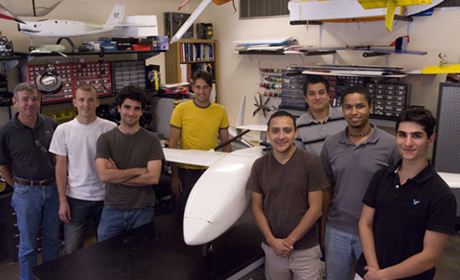
Walking into aerospace engineering Professor Armand Chaput’s lab can feel more like entering a model airplane shop.
Hanging from the ceiling are yellow, navy, orange and white planes – some with wings spanning 8 ft. across and bare Longhorn stickers, and another that has drawn-on shark teeth and eyes extending from the nose of the plane.
But don’t be fooled. These planes are not toys of hobby enthusiasts who fly model planes as a weekend pass time (though Chaput and his students do this regularly to test their creations and they talk with enough passion about their work that it may as well be a hobby for them too – not a job or a lab project.) The planes, known as unmanned aircraft systems (UAS), are capable of being remotely piloted and embedded with intelligence to recognize and identify designated objects – starting small with something like a square-shaped box in a small field to, on a much larger scale, detecting a person in a dense, urban city.
Such aircraft, also known as unmanned aircraft vehicles, have received widespread attention lately for their use in dangerous operations overseas. Because they can fly in areas deemed too risky for piloted aircraft, they offer an appealing alternative to traditional flying that technology has made possible.
Their civil uses – while less mature and more under the radar than military applications – have been highly valued in recent years, beginning with search and rescue missions during Hurricane Katrina and, most recently, to assess nuclear facilities in Japan following the March 11 earthquake and tsunami.
Research momentum to develop UASs for broad-scale civil uses is growing, and faculty and students in the Department of Aerospace Engineering & Engineering Mechanics and the Department of Electrical & Computer Engineering are helping to lead the way on their development.
The two departments are working collaboratively to create unmanned aircraft systems that can fly autonomously, or with the ability to make decisions without human intervention.
“UASs are totally dependent on communications. If I’m flying my airplane and I lose my communications link, as a pilot I know what to do even if I’m in the Dallas/Fort Worth airspace,” Chaput said. “The problem with a UAS is that if you lose the communications link to the plane, there’s no one inside the aircraft who can take care of it and make decisions."
Andreas Gerstlauer, an assistant professor in electrical and computer engineering, said the goals of the collaborative research project, known as Horus, are twofold: to build a communications infrastructure that relays real-time information – such as live video streaming and GPS coordinates – to and between constantly moving vehicles. Secondly, the research aims to design the vehicles so that they are smart and reliable enough to co-operate towards achieving a common goal without assistance.
“Overall, we want to build a flexible and modular infrastructure that researchers can later use as a test-bed for a wide array of applications,” Gerstlauer said.
Aerospace and ECE students are building UASs from scratch – down to the vehicle’s navigational and autopilot systems to an imaging recognition system that can detect a pre-programmed object, such as a geometric shape, a color or a number.
Over the past two years, the students have been recognized for their work during an annual competition to design, fabricate and demonstrate a system capable of completing a specific and independent aerial operation. The student competition, hosted by the Association for Unmanned Vehicle Systems International, is held in Maryland.
“We’ve been further behind other teams because we choose to build everything ourselves while most teams buy their technology and supplies off the shelves,” said Jon Tamir, a fourth-year ECE undergraduate, who built an imaging recognition system for the UAS vehicle, named Phoenix II, that students will enter in this year’s competition.
The end goal of the technology is that it could be used in civil uses by employing not just one, complex UAS, but a swarm of smaller autonomous aircraft that do the same job and learn how to communicate with each other reliably.
There are of course challenges to such a feat. For starters, there are currently no rules and regulations written over how UASs can operate in civilian air space. Even during search and rescue missions during Katrina, the Federal Aviation Administration was reluctant to let the aircraft fly because they are not certified, Chaput said, though pressure is mounting to change this.
Another challenge is how to build communications over wireless links between moving points instead of relatively stable points. UASs can go from close to each other with a high-quality signal, to out of range and barely operational very quickly, Chaput said, so the trajectory of the airplane is driven a lot by the communications system, and vice versa.
Ultimately, Chaput’s dream is for people to one day have their own personal airplanes.
“When I’m driving down Mopac and traffic turns to a halt, I don’t know whether it’s an accident or a stalled motorist,” he said. “I want to be able to launch a vehicle that scoots up ahead and sends a message to my cell phone and tells me what’s going on so I can know what to do.”
Andreas Gerstlauer holds the Advanced Micro Devices (AMD) Chair in Computer Engineering.







